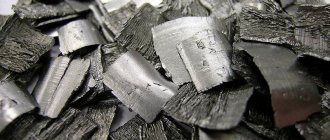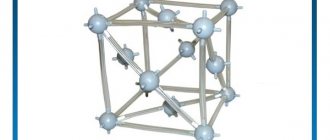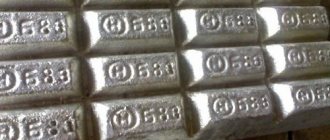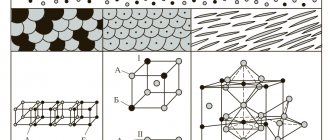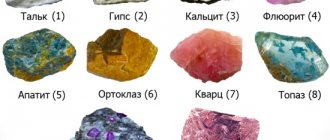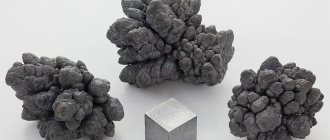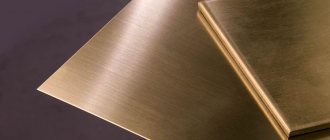Lead is an element of the fourth group of the main subgroup of the corresponding table of elements. Lead in its simplest form is a low-melting, malleable metal, white in color with a silvery tint and a bluish tint.
This type of material has been used for many millennia, as it is easily mined, perfectly processed and distributed in all corners of the world. Although native lead is very rare, it is widely found in a variety of other rocks. About eighty different types of rocks contain lead.
Lead Density:
Density is a scalar physical quantity, defined as the ratio of the mass of a body to the volume occupied by this body.
The Greek letter ρ is commonly used to denote density.
ρ = m / V, where m is the mass of the body, V is its volume.
The density of lead (ρ) is 11.3415 g/cm3 or 11341.5 kg/m3.
The density of lead is given under normal conditions (according to IUPAC), i.e. at 0 °C and pressure 10 5 (100,000) Pa.
For information: 101,325 Pa = 1 atm = 760 mm Hg. Art.
It must be borne in mind that the density of metals can change depending on environmental conditions (temperature and pressure). The exact value of the density of metals depending on environmental conditions (temperature and pressure) must be looked at in reference books.
Note: © Photo https://www.pexels.com, https://pixabay.com
Polls
Does our country need industrialization?
- Yes, we need it (90%, 2,486 votes)
Total votes: 2 758
Search for technologies
Technologies found 1
Might be interesting:
Dispersants for protecting pipelines from corrosion
Heterostructures
UAV for agriculture
Robot truck
Super strong wood
Extrusion plant for the production of consumables for 3D printers
Ultraconcrete – production technology using the gravitational compaction method
Hypersonic aircraft
What is this site about?
This site is dedicated to the Second Industrialization of Russia.
It includes: - the economy of the Second Industrialization of Russia, - the theory, methodology and tools of innovative development - the implementation of the Second Industrialization of Russia, - the organizational mechanism for the implementation of the Second Industrialization of Russia, - a directory of breakthrough technologies.
We do not sell products, technologies, etc. of manufacturers and inventors! You need to contact them directly!
We negotiate with manufacturers and inventors of domestic breakthrough technologies and provide recommendations on their use.
The implementation of the Second Industrialization of Russia is based on a qualitatively new scientific basis (theory, methodology and tools) developed by the authors of the site.
The end result of the Second Industrialization of Russia is an increase in the well-being of every member of society: the ordinary person, the enterprise and the state.
The second industrialization of Russia is a set of scientific, technical and other innovative ideas, projects and developments that have the ability to be widely implemented in economic practice in a short time (3-5 years), which will ensure a qualitatively new progressive development of society in the next 50-75 years.
The country that will be the first to make this comprehensive breakthrough, Russia, will become a leader in the world community and will remain inaccessible to other countries for centuries.
Lead is a soft, heavy metal of a silver-gray color, shiny, but quickly losing its shine. Along with tin and copper, it is one of the elements known to mankind since ancient times. Lead was used very widely, and even now its use is extremely diverse. So, today we will find out whether lead is a metal or a non-metal, as well as a non-ferrous or ferrous metal, we will learn about its types, properties, application and extraction.
What is lead
Lead is an element of group 14 of D.I. Mendeleev’s table, located in the same group with carbon, silicon and tin. Lead is a typical metal, but it is inert: it reacts extremely reluctantly even with strong acids.
Molecular weight is 82. This not only indicates the so-called magic number of protons in the nucleus, but also the large weight of the substance. The most interesting qualities of the metal are associated precisely with its great weight.
Read also: How to check a pulse transformer for interturn short circuit
The concept and features of lead metal are discussed in this video:
Concept and features
Lead is a metal that is quite soft at normal temperatures and is easy to scratch or flatten. This plasticity makes it possible to obtain metal sheets and rods of very small thickness and any shape. Malleability was one of the reasons why lead began to be used since ancient times.
The lead water pipes of Ancient Rome are well known. Since then, this type of water supply system has been installed more than once and in more than one place, but it did not operate for so long. Which, without a doubt, saved a considerable number of human lives, since lead, alas, with prolonged contact with water, eventually forms soluble compounds that are toxic.
Toxicity is the very property of a metal due to which they try to limit its use. Metal vapors and many of its organic and inorganic salts are very dangerous for both the environment and people. Basically, of course, the workers of such enterprises and residents of the area around the industrial facility are in danger. 57% is emitted with large volumes of dusty gas, and 37% with converter gases. There is only one problem with this - the imperfection of purification plants.
However, in other cases people become victims of lead contamination. Until recently, the most effective and popular gasoline stabilizer was tetraethyl lead. When fuel burned, it was released into the atmosphere and polluted it.
But lead has another, extremely useful and necessary quality - the ability to absorb radioactive radiation. Moreover, the metal absorbs the hard component even better than the soft one. A 20 cm thick lead layer can protect against all types of radiation known on Earth and in nearby space.
Advantages and disadvantages
Lead combines extremely useful properties, turning it into an irreplaceable element, and downright dangerous ones, which make its use a very difficult task.
The advantages from the point of view of the national economy include:
- fusibility and malleability - this allows you to form metal products of any degree of complexity and any subtlety. Thus, for the production of sound-absorbing membranes, lead plates with a thickness of 0.3–0.4 mm are used;
- lead is able to form an alloy with other metals (including tin, copper, zinc, etc.) that under normal conditions do not alloy with each other; its use as solder is based on this quality;
- metal absorbs radiation. Today, all elements of radiation protection - from clothing to the decoration of X-ray rooms and rooms at testing sites - are made from lead;
- The metal is resistant to acids, second only to noble gold and silver. So it is actively used for lining acid-resistant equipment. For the same reasons, it is used to produce pipes for the transfer of acid and for wastewater in hazardous chemical plants;
- The lead-acid battery has not yet lost its importance in electrical engineering, as it allows one to obtain a high voltage current;
- low cost - lead is 1.5 times cheaper than zinc, 3 times cheaper than copper, and almost 10 times cheaper than tin. This explains the very great benefit of using lead rather than other metals.
- toxicity - the use of metal in any type of production poses a danger to personnel, and in case of accidents - an extreme danger to the environment and the population. Lead belongs to substances of hazard class 1;
- Lead products should not be disposed of as regular waste. They require disposal and sometimes it is very expensive. Therefore, the issue of metal recycling is always relevant;
- Lead is a soft metal, so it cannot be used as a structural material. Considering all his other qualities, this should rather be considered a plus.
Read also: Working with a tester for beginners
Next, the melting point and density of lead, specific heat capacity and mass, as well as other properties and characteristics of such a metal will be considered.
Lead
Lead metal has several useful mechanical properties, including high density, low melting point, ductility, and relative inertness. Many metals are superior to lead in some of these aspects, but they are generally less abundant and more difficult to extract from their ores. Lead's toxicity has led to the phasing out of some of its uses. Lead has been used to make bullets since their invention in the Middle Ages. Lead is inexpensive; its low melting point means that small arms ammunition can be cast with minimal use of technical equipment; In addition, lead is denser than other common metals, which allows it to better maintain speed. Concerns have been raised that lead bullets used for hunting may be harmful to the environment. Its high density and corrosion resistance have been used in a number of related applications. Lead is used as a keel on ships. Its weight allows it to counterbalance the cocking effect of the wind on the sails; being so dense, it takes up little volume and minimizes water resistance. Lead is used in scuba diving to counteract the diver's ability to float to the surface. In 1993, the base of the Leaning Tower of Pisa was stabilized with 600 tons of lead. Because of its corrosion resistance, lead is used as a protective sheath for submarine cables. Lead is used in architecture. Lead sheets are used as roofing materials, cladding, flashing, gutters and downspout joints, and roof parapets. Lead moldings are used as a decorative material to secure lead sheets. Lead is still used in the making of statues and sculptures. 44) In the past, lead was often used to balance car wheels; For environmental reasons, this use is being phased out. Lead is added to copper alloys such as brass and bronze to improve their machinability and lubrication properties. Being virtually insoluble in copper, lead forms hard globules in imperfections throughout the alloy, such as grain boundaries. In low concentrations, and also as a lubricant, the globules prevent chip formation during the alloy's operation, thereby improving machinability. Bearings use copper alloys with a higher concentration of lead. Lead provides lubrication and copper provides load-bearing support. Due to its high density, atomic number and formability, lead is used as a barrier that absorbs sound, vibration and radiation. Lead has no natural resonant frequencies, and as a result, lead sheet is used as a soundproofing layer in the walls, floors and ceilings of sound studios. 45) Organic pipes are often made from a lead alloy mixed with varying amounts of tin to control the tone of each pipe. Lead is a radiation shielding material used in nuclear science and in X-ray cameras: gamma rays are absorbed by electrons. Lead atoms are densely packed and their electron density is high; A high atomic number means there are many electrons per atom. Molten lead was used as a coolant for lead-cooled fast reactors. The greatest use of lead was observed at the beginning of the 21st century in lead-acid batteries. The reactions in the battery between lead, lead dioxide and sulfuric acid provide a reliable source of voltage. The lead in batteries is not exposed to direct contact with people and is therefore associated with less of a toxic threat. Supercapacitors containing lead-acid batteries have been installed in kilowatts and megawatts in Australia, Japan and the US in frequency control, solar power smoothing and other applications. 46) These batteries have lower energy density and charge discharge efficiency than lithium-ion batteries, but are significantly cheaper. Lead is used in high voltage power cables as a sheath material to prevent water diffusion during thermal insulation; such use is decreasing as lead is phased out. Some countries are also reducing the use of lead in electronics solders to reduce environmentally hazardous waste. Lead is one of three metals used in the Oddy test for museum materials, helping to detect organic acids, aldehydes and acid gases. 47)
Properties and characteristics
Lead is a soft, malleable, but also heavy and dense metal. The molecular lattice is cubic, face-centered. Its strength is low, but its ductility is excellent. The physical characteristics of the metal are as follows:
- density at normal temperature 11.34 g/cm3;
- melting point – 327.46 C;
- boiling point – 1749 C;
- resistance to tensile load – 12–3 MPa;
- resistance to compressive load – 50 MPa;
- Brinell hardness – 3.2–3.8 HB;
- thermal conductivity – 33.5 W/(m K);
- The resistivity is 0.22 ohm-sq. Mmm.
Like any metal, it conducts electric current, although, it should be noted, it is much worse than copper - almost 11 times. However, the metal has other interesting properties: at a temperature of 7.26 K it becomes a superconductor and conducts electricity without any resistance. Lead was the first element to exhibit this property.
Paints containing lead compounds are almost as resistant to corrosion. Due to toxicity, they are not used indoors, but are successfully used when painting bridges, for example, frame structures and so on.
The video below will show you how to make pure lead:
Indicators of the specific gravity of other metals
Specific gravity is an indicator that is an integral characteristic of other metals.
The specific gravity of silver is affected by the fineness of the alloy. When other metals (copper, nickel) are added to it, the specific gravity and density are lost. Thus, the density of copper is 8.93 g/cm3, nickel – 8.91 g/cm3. All values are calculated using formulas.
You may be interested in: Properties of gold: physical and chemical properties
Silver is the same noble metal as gold. Its specific gravity is 10.5 g/cm3. It melts at a temperature of 960 degrees. The main physical characteristics of silver are:
- corrosion resistance;
- low resistance;
- increased light reflectivity.
Despite its natural softness, silver has a high density and specific gravity.
Titanium is a non-ferrous metal of a white-silver hue. It has high strength, although it is light in weight. So, it is 12 times stronger than aluminum and 4 times stronger than copper and iron. In terms of the degree of presence in the earth's crust, titanium is given fourth place among the rest.
The low specific gravity of titanium - 4.505 g/cm3 is more consistent with alkali metals. An oxide film forms on its surface, which prevents the formation of corrosion.
Zinc is also a non-ferrous metal with a white-bluish tint. It has medium hardness and an initial melting point of 419 degrees. Under the influence of a temperature of 913 degrees, this metal acquires a vaporous state. Zinc has a specific gravity of 7.13 g/cm3.
Normal temperature makes zinc brittle, but increasing it to 100 degrees makes the metal flexible and ductile. When interacting with air, an oxide film forms on the surface of zinc.
The color of lead is dirty gray, but this does not affect the natural shine of the metal. However, the glow stops quite quickly due to the formation of an oxide film on the surface of the lead. The lead alloy has a high specific gravity - 11.337 g/cm3. In this indicator, it exceeds zinc, aluminum, iron and some other metals. Despite its high density, lead is a very soft metal.
It is easy to knead in your hands or scratch with your nails. For lead, a temperature of 327.5 degrees is enough for it to begin to melt.
The table shows the specific gravity and melting points of other metals.
You may be interested in: Is it possible to combine gold and silver?
| Name of metal | Melting point, °C | Specific gravity, g/cc |
| Zinc | 419.5 | 7.13 |
| Aluminum | 659 | 2.69808 |
| Lead | 327.4 | 11.337 |
| Tin | 231.9 | 7.29 |
| Copper | 1083 | 8.96 |
| Titanium | 1668 | 4.505 |
| Nickel | 1455 | 8.91 |
| Magnesium | 650 | 1.74 |
| Vanadium | 1900 | 6.11 |
| Tungsten | 3422 | 19.3 |
| Chromium | 1765 | 7.19 |
| Molybdenum | 2622 | 10.22 |
| Silver | 1000 | 10.5 |
| Tantalum | 3269 | 16.65 |
| Iron | 1535 | 7.85 |
| Gold | 1095 | 19.32 |
| Platinum | 1760 | 21.45 |
Metal production
Lead is quite common, forms several industrially important minerals - galena, cerussite, anglesite, so its production is relatively cheap. The metal is obtained by pyrometallurgical and hydrometallurgical methods. The second method is safer, but is used much less frequently, since it is more expensive, and the resulting metal still needs final processing at high temperatures.
Production using the pyrometallurgical method includes the following stages:
- ore mining;
- crushing and enrichment mainly by flotation method;
- smelting for the purpose of obtaining crude lead - reduction, furnace, alkaline, and so on;
- refining, that is, purifying black lead from impurities and obtaining pure metal.
Despite the same production technology, the equipment can be used in very different ways. This depends on the metal content in the ore, production volumes, product quality requirements, and so on.
Read below about the use and price per 1 kg of lead.
Application area
The first use of lead - in the manufacture of water pipes and household items, fortunately, dates back to quite a long time ago. Today, metal enters a home only with a protective layer and in the absence of contact with food, water and humans.
- But the use of lead for alloys and as solder began at the dawn of civilization and continues to this day.
- Lead is a metal of strategic importance, especially since bullets began to be cast from it. Ammunition for small arms and sporting weapons is still made only from lead. And its compounds are used as explosives.
- 75% of the world's metal production is used to produce lead-acid batteries. The substance continues to be one of the main elements of chemical current sources.
- The corrosion resistance of the metal is exploited in the manufacture of acid-resistant equipment, pipelines, and protective sheaths for power cables.
- And, of course, lead is used in the equipment of X-ray rooms: cladding of walls, ceilings, floors, protective partitions, protective suits - everything is made with the participation of lead. At testing sites, including nuclear ones, metal is indispensable.
Read also: How to cut a double-start thread
The cost of metals is determined on several world-wide exchanges. The most famous is the London Metal Exchange. The cost of lead in October 2016 is $2087.25 per ton.
Lead is a metal that is in great demand in modern industry. Some of its qualities—corrosion resistance, the ability to absorb hard radiation—are completely unique and make the metal irreplaceable despite its high toxicity.
This video will tell you what happens if you pour lead into water:
The main characteristic affecting the weight of a metal is its density.
What does metal density mean?
The density of a metal refers to its weight per unit of occupied volume. Volume is often measured in cubic meters and cubic centimeters. What is the reason for such large, by earthly standards, weight and density? The density of a metal and its weight depend on how small the radius of the atom is and how large its weight is.
Density of metals table
| Metal | g/cm 3 | kg/m 3 | Metal | g/cm 3 | kg/m 3 |
| Lithium | 0,534 | 534 | Samarium | 7,536 | 7536 |
| Potassium | 0,87 | 870 | Iron | 7,87 | 7874 |
| Sodium | 0,968 | 9680 | Gadolinium | 7,895 | 7895 |
| Rubidium | 1,53 | 1530 | Terbium | 8,272 | 8272 |
| Calcium | 1,54 | 1540 | Dysprosium | 8,536 | 8536 |
| Magnesium | 1,74 | 1740 | Niobium | 8,57 | 8570 |
| Beryllium | 1,845 | 1845 | Cadmium | 8,65 | 8650 |
| Cesium | 1,873 | 1873 | Holmium | 8,803 | 8803 |
| Silicon | 2,33 | 2330 | Nickel | 8,9 | 8900 |
| Bor | 2,34 | 2340 | Cobalt | 8,9 | 8900 |
| Strontium | 2,6 | 2600 | Copper | 8,94 | 8940 |
| Aluminum | 2,7 | 2700 | Erbium | 9,051 | 9051 |
| Scandium | 2,99 | 2990 | Thulium | 9,332 | 9332 |
| Barium | 3,5 | 3500 | Bismuth | 9,8 | 9800 |
| Yttrium | 4,472 | 4472 | Lutetium | 9,842 | 9842 |
| Titanium | 4,54 | 4540 | Molybdenum | 10,22 | 10220 |
| Selenium | 4,79 | 4790 | Silver | 10,49 | 10490 |
| Europium | 5,259 | 5259 | Lead | 11,34 | 11340 |
| Germanium | 5,32 | 5320 | Thorium | 11,66 | 11660 |
| Arsenic | 5,727 | 5727 | Thallium | 11,85 | 11850 |
| Gallium | 5,907 | 5907 | Palladium | 12,02 | 12020 |
| Vanadium | 6,11 | 6110 | Ruthenium | 12,4 | 12400 |
| Lanthanum | 6,174 | 6174 | Rhodium | 12.44 | 12440 |
| Tellurium | 6,25 | 6250 | Hafnium | 13,29 | 13290 |
| Zirconium | 6,45 | 6450 | Mercury | 13,55 | 13550 |
| Cerium | 6,66 | 6660 | Tantalum | 16,6 | 16600 |
| Antimony | 6,68 | 6680 | Uranus | 19,07 | 19070 |
| Praseodymium | 6,782 | 6782 | Tungsten | 19,3 | 19300 |
| Ytterbium | 6,977 | 6977 | Gold | 19,32 | 19320 |
| Neodymium | 7,004 | 7004 | Plutonium | 19,84 | 19840 |
| Zinc | 7,13 | 7130 | Rhenium | 21,02 | 21020 |
| Chromium | 7,19 | 7190 | Platinum | 21,40 | 21400 |
| Tin | 7,3 | 7300 | Iridium | 22,42 | 22420 |
| Indium | 7,31 | 7310 | Osmium | 22,5 | 22500 |
| Manganese | 7,44 | 7440 |
The table shows that the specific gravity of a cube of metal varies greatly. The difference in weight between the heaviest and lightest metal is 42 times. Osmium, whose weight is 22500 kg per m 3 and lithium, which has the lowest density, whose weight is 534 kg per m 3. The metal that has the greatest density also has the greatest weight and it is osmium, as we already understood.
The average density among all metals is 11.5 g per cm3.
It is also noteworthy that there are metals whose density is less than water. There are several of them: lithium, potassium, sodium.
For reference, we can add that osmium is not only the heaviest, but also the rarest. It is mined at around 100 kg per year.
Technical indicators of metal alloys
The most common copper-based alloys are brass and bronze . Their composition is also formed from other elements:
All alloys differ in structure. The presence of tin in the composition allows the production of bronze alloys of excellent quality. Cheaper alloys include nickel or zinc. The produced materials based on Cuprum have the following characteristics:
- high ductility and wear resistance;
- electrical conductivity;
- resistance to aggressive environments;
- low coefficient of friction.
Read also: Is it possible to solder stainless steel
with tin Copper-based alloys are widely used in industrial production. They are used to produce dishes, jewelry, electrical wires and heating systems. Materials with Cuprum are often used to decorate the façade of houses and make compositions. High stability and ductility are the main qualities for the use of the material.
Also, do not forget that the specific gravity of a metal is the force of gravity directly taken as a basis for the volume of a given substance.
The specific gravity of a metal and its density are in the same relationship to each other as the weight and mass of a body, and therefore the specific gravity can be determined by the formula:
The unit of specific gravity of a metal (stainless steel, brass, cast iron, copper, bronze, etc.) is:
– in the SGS system - 1 dyne/cm 3,
– in the SI system - 1 n/m 3,
– in the MKSS system—1 kg/m3.
All these unit values are related to each other by the relation
0.1 dyne/cm3 = 1 n/m3 = 0.102 kg/m3.
When determining the specific gravity of a metal, it is also possible to use a non-systemic unit of 1 G/cm 3 .
Since the mass of a substance, expressed in g, is equal to its weight value, expressed in G, the specific gravity of the metal, expressed in these units, is equal in number to the density of this metal, which will be expressed in the CGS system. A similar numerical equality can be traced between the specific gravity in the MKSS system and the density in the SI system.
Thus, the specific gravity of a metal is the weight per unit volume of an unconditionally dense (non-porous) material. To indicate the specific gravity, the mass of the dry material should be divided by its volume in a fully dense state - in fact, this is the formula for determining the weight of the metal. In order to achieve such a result, the metal must be brought into such a state that there are no pores in its particles, and the structure is completely homogeneous.
All metals known and used in industry have certain physical and mechanical properties, which, in fact, determine their specific gravity. There are several fundamental criteria that uniquely identify a particular metal or alloy.
Features of metals and their quality and weight characteristics
In order to have a more accurate understanding of the specifications of each type of metal, it is necessary to determine what is meant by this group of substances.
Metals are substances that have characteristic properties, including high strength, thermal and electrical conductivity, ductility, and a special metallic luster characteristic of each group. Metallic elements make up almost 3/4 of all elements known in nature, but not all of them can be widely used in industry. Some of them are quite rare in their true condition and specific gravity. Of the most important and valuable metals for technological processes and production, only a small part is contained in the earth’s crust. These are iron, aluminum, magnesium, titanium, etc.
Specific gravity of cast iron
Ferrous metals (black steel, cast iron) are the technical name for iron alloys and iron itself. For thousands of years they have been fundamental in the making of tools. Despite the stable growth in production of the chemical industry, non-ferrous metallurgy, and heavy industry, ferrous metals are still considered the main structural material in many sectors of human activity. In terms of production volumes of most of the most important types of ferrous metallurgy products (iron ore, cast iron, steel, steel pipes, coke, refractories), Russia occupies a worthy place as a leader throughout the world. Ferrous metals are divided into cast iron and steel depending on their carbon content and their specific gravity.
Cast iron is an alloy of carbon and iron with a carbon content of more than 2.13%. Cast iron is endowed with a low capacity for plastic deformation and excellent casting properties. It contains graphite inclusions - the shape and size of which determine the type of cast iron and its scope of application. Gray cast iron is a material in which carbon is contained in a free state in the form of flake graphite. High-strength cast iron contains carbon in the form of spheroidal graphite, and is used for the manufacture of parts that are subject to significant mechanical loads during operation. Malleable cast iron may have increased ductility characteristics when compared to the above cast iron. It is used in the production of parts where higher levels of mechanical properties are required.
The specific gravity of cast iron and its alloys is determined by the weight of one cubic centimeter, which is expressed in grams . The higher the specific gravity of the metal, the heavier the finished product can be. The table below illustrates the typical physical properties and specific gravity associated with certain types of cast iron.
| Specific gravity of steel Specific gravity of stainless steel Specific gravity of copper and copper alloys Specific gravity of aluminum Specific gravity of brass Specific gravity of bronze To calculate the weight or length of rolled metal based on the specific gravity of the desired grade, there is a special metal calculator. See also tables: Specific gravity of titanium, nickel, zinc Determination of the specific gravity of metals. Modern science has long stepped forward compared to the technologies that were used at the dawn of the development of heavy industry, and can offer various variations of metal alloys that differ from each other not only in their qualitative characteristics, but also in their physical and chemical properties. In order to determine how suitable a particular alloy of black or stainless steel is for production, its specific gravity is calculated. All bodies that have the same volume, but are made from different substances, for example, from iron, brass or aluminum, have different mass, which is directly dependent on its volume. In other words, the ratio of the volume of the alloy to its mass is a constant value that will be characteristic of a given substance. The density of a substance is calculated using a special formula and is directly related to the calculation of the specific gravity of the metal. The specific gravity of a metal is the ratio of the weight P of a homogeneous body of this substance to the volume of the metal. It is denoted by γ. Then, according to the formula, the specific gravity of metals is calculated as: |
Read also: How much oil to fill in a hydraulic jack
| Table 1. Typical physical properties and specific gravity of cast iron | |||||
| Cast iron type | Specific gravity G/cm3 | Coefficient of thermal linear expansion a·10 -v 1/ о С, at temperatures 20-100 о С | Heat capacity in cal/G o C | Residual magnetism in gs | Note, with increasing temperature: “+” – increases; “-” – decreases |
| White | 7,5±0,2 | 8±2 | 0,13±0,02 | 5000±1000 | «-» |
| Grey | 7,1±0,2 | 10±2 | 0,12±0,02 | 5000±1000 | «+» |
| Malleable | 7,3±0,1 | 11±1 | 0,12±0,02 | 5000±1000 | «-» |
In addition to the non-bulk group of light metals, such as aluminum, magnesium, which have a specific gravity of no more than 3, most metals can have a significant specific gravity individually. For example, due to the large specific gravity of platinum (21.45) and gold (19.32), found in natural form, they can be mined using the method of washing from relatively light particles of sand and clay that accompany them in different layers of the soil.
The low specific gravity of some metals is very important in the construction and design of aircraft, and therefore, at the moment, light alloys and their characteristics are being especially carefully studied.
To calculate any rolled metal product by specific gravity, there is a special metal calculator for this.
_ _ _ _ _ _ _ _ _ _ _ _ _ _ _ _ _ _ _ _ _ _ _ _ _ _ _ _ _ _ _ _ _ _ _ _ _ _ _ _ _ _ _ _ _ _ _ _ _ _ _ _ _ _ _ _ _ _ _ _ _ _ _ _ _ _ _ _ _ _ _ _ _ _ _ _ _ _ _ _ _ _ _ _ _ _ _ _ _ _ _ _ _ _ _ _ _ _ _ _ _ _ _ _ _ _ _ _ _ _ _ _ _ _ _ _ _ _ _ _ _ _ _ _ _ _ _ _ _ _ _ _ _ _ _ _ _ _ _ _ _ _ _ _ _ _ _ _ _ _ _ _ _ _ _ _ _ _ _ _ _ _ _ _ _ _ _ _ _ _ _ _ _ _ _ _ _ _ _ _ _ _ _ _ _ _ _ _ _ _ _ _ _ _ _ _ _ _ _ _ _ _ _ _ _ _ _ _ _ _ _ _ _ _ _ _ _ _ _ _ _ _ _ _ _ _ _ _ _ _ _ _ _ _ _ _ _ _ _ _ _ _ _ _ _ _ _ _ _ _ _ _ _ _ _ _ _ _ _ _ _ _ _ _ _ _ _ _ _ _ _ _ _ _ _ _ _ _ _
Each metal has certain physical and chemical properties. They determine their specific gravity and density. Thus, pure gold is a metal with increased heaviness and no less high density - 19.32 g/cm3. This figure puts gold in seventh place among all metals.
Different systems use different units of measurement: SI = N/M3, MCSS = 1 kg/m3, CGS = 1 dyne/cm3. In addition, the specific gravity of gold is expressed in grams per cubic centimeter. This is a non-system unit of measurement.
